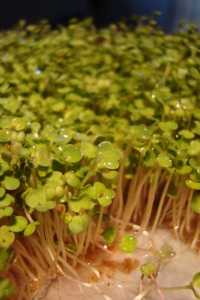
One thing that keeps me happy over winter are my bonsai rocket gardens. Leaving the house for work when it’s dark and getting home in the some disposition, doesn’t allow time for garden therapy. So I’ve been bringing it inside. I spread them on to paper towels on an ice cream container lid, sprinkle water over it once a day and here in winter it usually takes 4 – 6 days to have yumminess. Then I just use them in everything.
High in nutrients and vitamins A, B, C and E, rocket (Eruca spp.) rocks over winter. The sprouts add a nice bit of warmth to any vegetable dish. I use them as a side vegetable for just about anything, sprinkle them on my tomato soup, add them to cheese sandwiches.

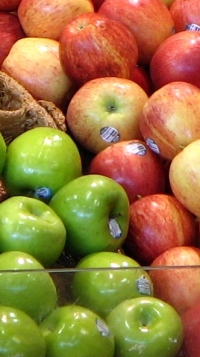 Lately, I’ve noticed more ads for fruit and vegetable washes to get rid of nasties like pesticides and fungicides. I wash produce thoroughly when I get it home from the supermarket (I don’t live out of my garden alone). And while I’ve generally been satisfied by this, it may be a good idea to step it up. But, I’m not prepared to buy expensive sprays to do it.
Lately, I’ve noticed more ads for fruit and vegetable washes to get rid of nasties like pesticides and fungicides. I wash produce thoroughly when I get it home from the supermarket (I don’t live out of my garden alone). And while I’ve generally been satisfied by this, it may be a good idea to step it up. But, I’m not prepared to buy expensive sprays to do it.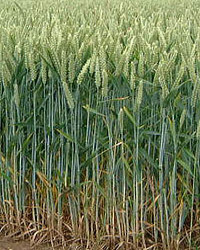 Yes, I’m afraid really. Due to current ill-health and a predilection for self-torture, I’m going gluten-free and soy-free for two months. Starting today. I feel low. At least I’m doing this by choice, I’d feel lower if this was the end of these long-time friends. It’s not – this is just an experiment.
Yes, I’m afraid really. Due to current ill-health and a predilection for self-torture, I’m going gluten-free and soy-free for two months. Starting today. I feel low. At least I’m doing this by choice, I’d feel lower if this was the end of these long-time friends. It’s not – this is just an experiment. I’m just a little perplexed by this article in the
I’m just a little perplexed by this article in the  I reckon that every garden should have Jerusalem artichokes (Helianthus tuberosus). It’s like an insurance policy – you’ll always have food growing in your yard. Because once you plant them, it’s almost certain you’ll always have them. And you won’t have to lift a finger to help them grow.
I reckon that every garden should have Jerusalem artichokes (Helianthus tuberosus). It’s like an insurance policy – you’ll always have food growing in your yard. Because once you plant them, it’s almost certain you’ll always have them. And you won’t have to lift a finger to help them grow.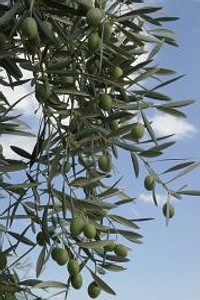 I’ve just tasted some beautiful olives a friend’s mum grew in her back yard and then pickled. Most generously, I was given a recipe to post here. I’ll have to wait to find a tree I can raid. I’ve spotted a few olive trees growing on properties around Kapiti. We’ve certainly have that salt-laden wind of the Mediterranean. Olive trees have incredibly long tap roots so they can survive in very dry coastal situations. There are some commercial growers a bit further north.
I’ve just tasted some beautiful olives a friend’s mum grew in her back yard and then pickled. Most generously, I was given a recipe to post here. I’ll have to wait to find a tree I can raid. I’ve spotted a few olive trees growing on properties around Kapiti. We’ve certainly have that salt-laden wind of the Mediterranean. Olive trees have incredibly long tap roots so they can survive in very dry coastal situations. There are some commercial growers a bit further north. I think that’s the last of my cherry tomatoes. Just as well really, I was getting totally sick of them. We had sooooo many. It was a bad year for tomatoes in the Wellington region and nearly all mine ended up being cherry-sized.
I think that’s the last of my cherry tomatoes. Just as well really, I was getting totally sick of them. We had sooooo many. It was a bad year for tomatoes in the Wellington region and nearly all mine ended up being cherry-sized.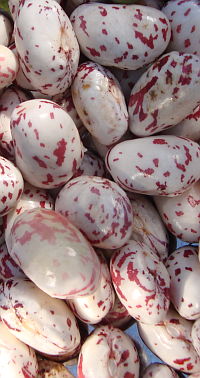 Grow your own food! But be patient – this is how long it will take. The chart looks at how long you can expect to wait for your vegetables to grow from seed. These are estimated times – climate, soil conditions, water supply, different cultivars, farming methods can all give different results.
Grow your own food! But be patient – this is how long it will take. The chart looks at how long you can expect to wait for your vegetables to grow from seed. These are estimated times – climate, soil conditions, water supply, different cultivars, farming methods can all give different results.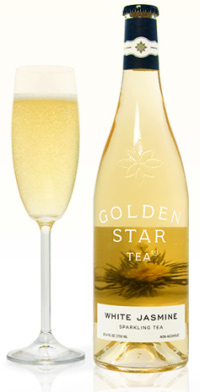 I may have just found my new favourite drink. Irony being, it’s unlikely to ever pass my lips. New Zealand’s age-old problem with the tyranny of distance is taunting me with the internet waivering delectable treats in front of my eyes.
I may have just found my new favourite drink. Irony being, it’s unlikely to ever pass my lips. New Zealand’s age-old problem with the tyranny of distance is taunting me with the internet waivering delectable treats in front of my eyes.